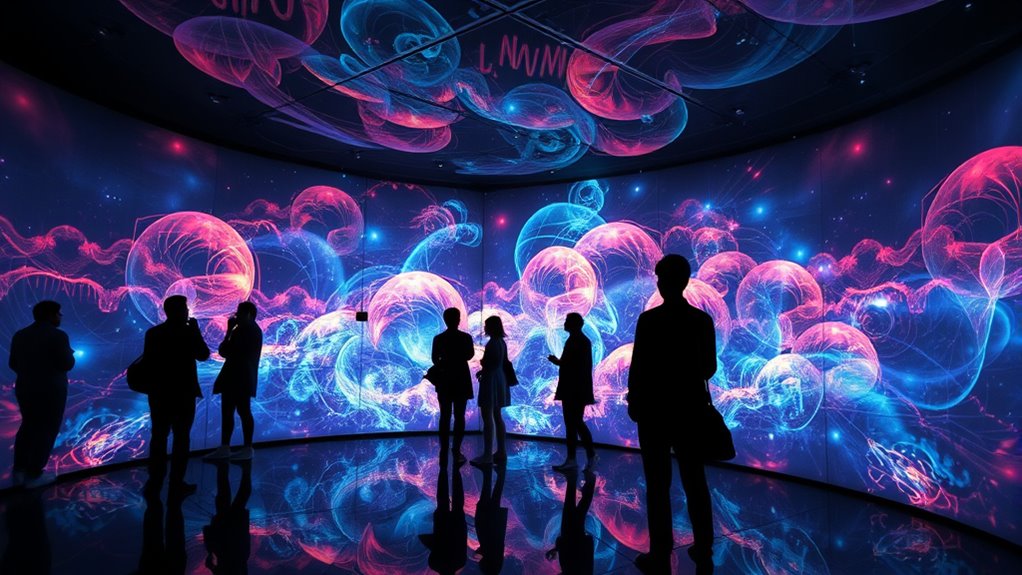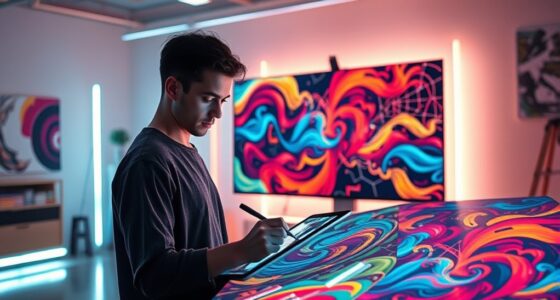Immersive AI installations merge music, visuals, and machine-generated worlds to create enthralling multisensory experiences. You interact with dynamic environments that respond to your movements, emotions, and gestures, making art feel personal and alive. AI adapts visuals and soundscapes in real-time, blurring the line between creator and audience. To discover how these innovative setups reshape perception and push artistic boundaries, explore further into this fascinating intersection.
Key Takeaways
- Immersive AI installations create dynamic, multisensory environments where music and visuals respond in real-time to user interactions.
- AI algorithms generate machine-imagined worlds that adapt and evolve based on sensor data and emotional cues from visitors.
- These installations seamlessly merge music with visual art, producing personalized, immersive experiences that blur the line between creator and audience.
- Techniques like real-time data analysis and machine learning enable environments to evolve naturally, enhancing emotional engagement.
- Future developments will deepen integration of AI-driven sound design and virtual worlds, expanding the boundaries of immersive art experiences.
The Evolution of Immersive Artistic Experiences
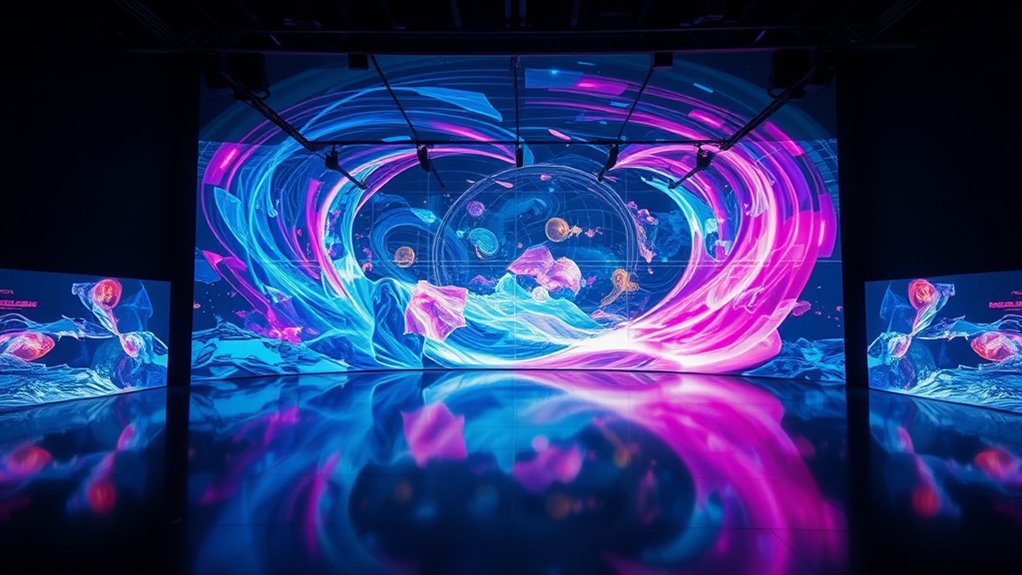
The evolution of immersive artistic experiences reflects a rapid shift from traditional displays to interactive, technology-driven environments. You’ve likely noticed how art no longer just sits on walls or in galleries; it surrounds you, engaging multiple senses at once. Early installations relied on simple visuals and sound, but now, advanced technology enables you to step into dynamic worlds created by projections, virtual reality, and augmented reality. These innovations transform passive observation into active participation, allowing you to explore and influence the environment. As artists push boundaries, your experience becomes more personalized and engaging. This progression highlights a move toward creating environments that are not just viewed but felt, experienced firsthand, and integrated into your sensory perception, fundamentally changing how you interact with art. The integration of technological tools like sensors and real-time data further enhances this immersive quality, making each experience uniquely tailored to the individual viewer.
How Artificial Intelligence Shapes Creative Environments
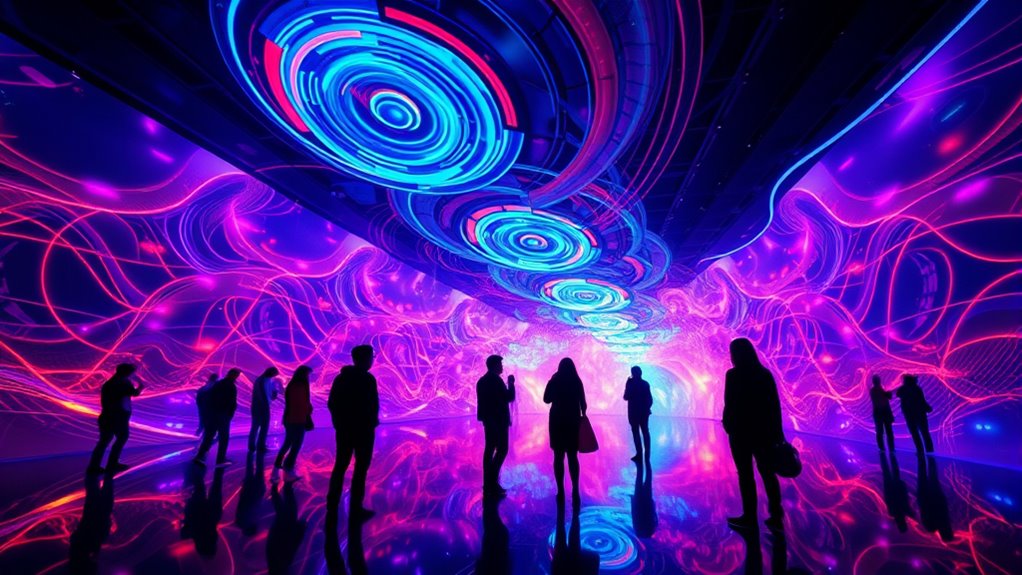
Artificial intelligence is revolutionizing the way creative environments are designed and experienced. You now have tools that adapt in real-time, responding to your movements, emotions, and interactions. AI algorithms analyze data from sensors, allowing environments to evolve dynamically and intuitively. This personalization creates immersive experiences where every visitor encounters something unique. Artists and designers leverage AI to craft complex visual landscapes, generate responsive soundscapes, and simulate environments that feel alive. Instead of static settings, AI-powered spaces become interactive, engaging, and constantly changing. You can influence the environment directly, making your presence integral to the experience. This shift enables creators to push boundaries, blending technology seamlessly with art, and fostering environments that are not only visually stunning but also deeply personalized and emotionally resonant. Moreover, automation’s role in business intelligence enhances the development of these immersive environments by providing real-time insights and predictive analytics to optimize user engagement.
The Intersection of Sound, Visuals, and Interactivity
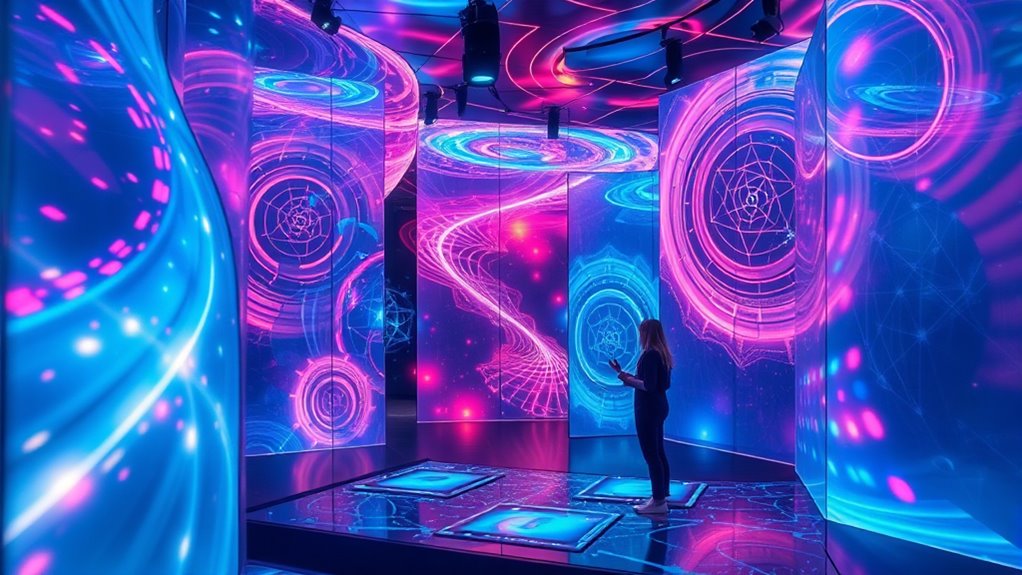
As immersive AI installations integrate sound, visuals, and interactivity, they create multisensory environments that respond seamlessly to your actions. When you move or make gestures, the system interprets your input, adjusting visuals and sound in real-time. This dynamic interplay deepens your engagement, making you feel like an active participant rather than a passive observer. AI algorithms analyze your behavior, tailoring audiovisual elements to enhance your experience. The visuals can morph in complexity or color based on your movements, while soundscapes evolve to reflect your emotional state. This fusion blurs boundaries between observer and creator, inviting you to influence the environment directly. The result is a cohesive, responsive environment that heightens immersion, making each interaction unique and deeply personalized. Additionally, cybersecurity vulnerabilities in AI systems underscore the importance of secure design to protect user data during these immersive experiences.
Notable Examples of AI-Driven Installations

Have you ever experienced an installation that responds so intuitively you forget it’s artificial? These AI-driven works create immersive environments where your presence influences the art itself. For example, teamLab’s “Borderless” uses AI to adapt visuals based on visitors’ movements, creating a seamless blend of human interaction and digital imagery. Another notable example is “The Treachery of Sanctuary,” where AI interprets your gestures to generate evolving visuals and sounds, making each experience unique. These installations harness machine learning to analyze real-time data, producing dynamic, personalized environments. The integration of interactive technology enables these works to react and evolve in response to visitors, heightening the immersive experience. They challenge traditional boundaries, immersing you in worlds where technology listens and responds as naturally as a human artist. By doing so, they redefine the art experience, making it more engaging and deeply personal.
Future Perspectives: Redefining Art and Perception
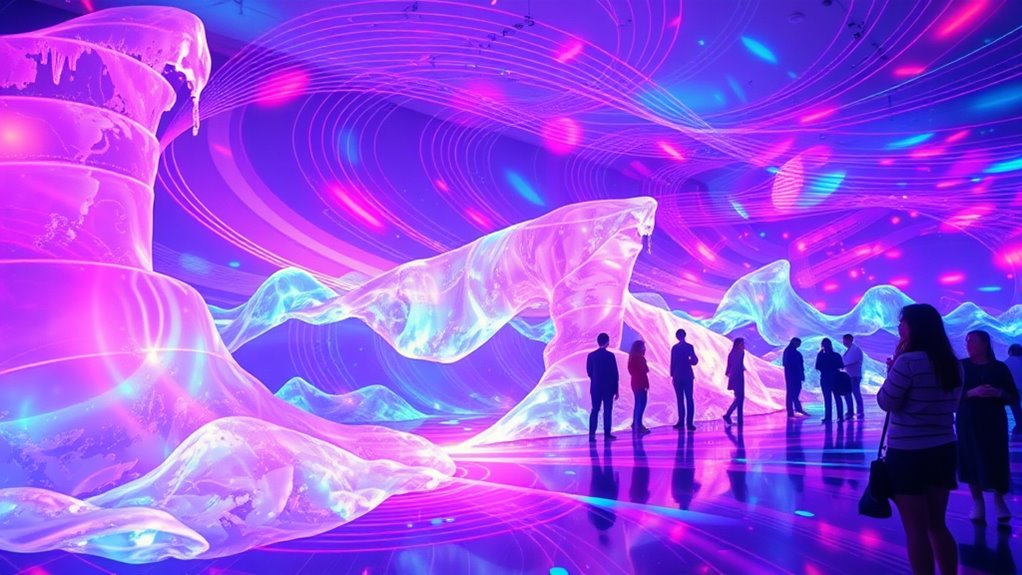
Emerging AI technologies are poised to transform how you experience and perceive art, blurring the lines between creator and audience. As AI continues to evolve, it will enable you to engage with immersive works that adapt in real-time, offering personalized journeys through sound, visuals, and interaction. This shift redefines traditional notions of authorship, making you an active participant rather than a passive observer. Future art installations will challenge your perception, encouraging you to question reality, perception, and emotional responses. AI-driven creativity will foster new forms of expression, blending human intuition with machine intelligence. Additionally, advances in sound design techniques and tools will allow for more sophisticated and immersive auditory experiences, further enhancing the depth of these interactive environments. As a result, you’ll encounter art that is dynamic, interactive, and deeply personalized—pushing the boundaries of how art influences, inspires, and transforms your understanding of the world around you.
Frequently Asked Questions
How Do Audience Reactions Influence Ai-Driven Immersive Installations?
Your reactions directly shape AI-driven immersive installations by guiding their evolution and responsiveness. When you express excitement, curiosity, or even hesitation, the system adapts, tailoring the experience to match your emotional state and preferences. This feedback loop creates a dynamic environment that feels personal and engaging. As a participant, your responses influence the installation’s future iterations, making the experience more immersive, meaningful, and uniquely yours each time you engage.
What Ethical Considerations Arise With Ai-Created Immersive Art?
You should consider ethical issues like consent, privacy, and authorship when engaging with AI-created immersive art. Make sure creators and participants understand how their data is utilized and who owns the work. Be aware of biases embedded in AI, which can reinforce stereotypes. Respect cultural sensitivities, and promote transparency about AI’s role. By addressing these concerns, you help ensure the technology benefits everyone ethically and responsibly.
How Accessible Are These Immersive Experiences to Diverse Audiences?
You might find that immersive AI experiences are becoming more accessible, but barriers remain. Factors like cost, language, and technological literacy can limit who gets to participate. To improve accessibility, creators need to design inclusive interfaces, offer multilingual options, and consider diverse physical abilities. By actively addressing these issues, you can help guarantee that more people from different backgrounds enjoy and benefit from these groundbreaking artistic worlds.
Can AI Installations Adapt in Real-Time to Individual Viewers?
Yes, AI installations can adapt in real-time to you. They analyze your movements, expressions, and reactions on the spot, then modify the experience instantly to enhance engagement. This dynamic responsiveness creates a personalized journey, making each visit unique. By leveraging machine learning algorithms, the installation learns from your interactions, ensuring the experience feels intuitive, immersive, and tailored just for you, deepening your connection to the art and technology.
What Skills Are Needed to Create Ai-Based Immersive Art?
To create AI-based immersive art, you need a mix of technical and creative skills. You should be comfortable with programming languages like Python or C++, and understand machine learning frameworks such as TensorFlow or PyTorch. Creativity is key, so you also need a good eye for design and user experience. Additionally, familiarity with sensors, real-time data processing, and software for digital art creation will help you craft compelling, interactive experiences.
Conclusion
As you explore immersive AI installations, you’re stepping into a living canvas where music and machine‑imagined worlds blend seamlessly, like colors bleeding into a sunset. These experiences are transforming how you perceive art, turning passive observation into active participation. As technology continues to evolve, you’ll find yourself immersed in ever more enchanting worlds, where creativity blooms at the intersection of human inspiration and machine intelligence—opening doors to a future where imagination knows no bounds.
